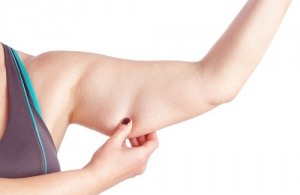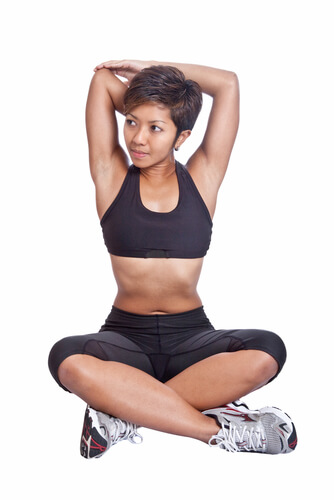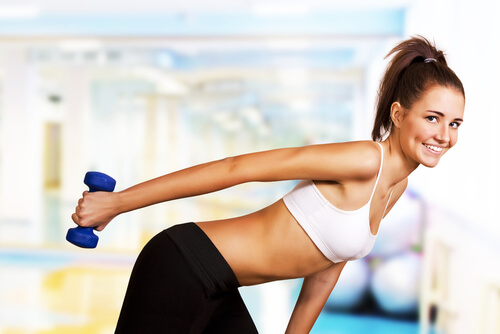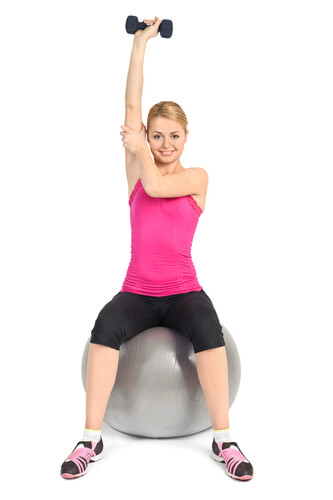Remedies and Exercises to Correct Arm Flaccidity

For many, having toned muscles makes us feel and look good. But over time, the first signs of flaccidity, especially arm flaccidity, begin to show, usually in our 30s onwards.
This could be due to lack of exercise, weight gain, pregnancy, sudden weight loss, hormonal changes, or poor diet. One of the most troublesome areas is the arms, giving an appearance that can be embarrassing due to their unsightly appearance, and that can sometimes cause difficulty while dressing.
Flaccidity is a loss of skin firmness due to collagen and elastin fiber degradation. This loosens the skin and muscles. It primarily affects the areas of the abdomen, the glutes, the thighs, and the arms.
Read more: The 8 Foods that Provide the Most Collagen for Your Skin
What can we do to correct this bothersome arm flaccidity?
There are lots of ways that can help you improve this situation, from natural remedies that help improve the look of our skin, to exercises aimed at strengthening and toning our arms.
Natural remedies:
- Apple: Firstly, mix half a glass of apple juice with half a glass of cantaloupe juice. Then massage this over the flaccid areas. You can do this twice a week.
- Cantaloupe: Firstly, wash and dice a small cantaloupe melon into several pieces. Then mix the pulp with a bit of water in a blender together with the juice of a medium lemon. Blend well and moisten gauze with the mixture, and then place on the affected area.
- Masks: Mix one tablespoon of honey, one tablespoon of olive oil, and one egg yolk. Then apply the paste to the arms for 15 minutes. Lastly, rinse with cold water.
Exercises
Regular exercises promote the increase of muscle mass, helping tighten the skin while also oxygenating it. Daily water intake should be at least 4 pints a day, and is also indispensable for keeping hydrated and toned skin.
See also: 5 Common Hydration Mistakes
Exercises to recover muscle tone in the arms:
- These exercises should be done after warming up, gently moving the shoulders, moving your hands towards the shoulders time and again, without dumbbells or extra weight.
- Stretching is also fundamental to prevent injuries or pain after exercising.
- Stretching before and after muscle strengthening should be done slowly, and should be accompanied by calm, deep breaths. Repeat at least 5 times on each side.
Muscle strengthening
You can do 3 sets of 8 repetitions for each exercise.
- Number 1: Place your knees on the ground, both legs slightly bent, and your palms supported on the ground. Arms should be straight, a shoulder width apart, without curving your spine. Bend your arms while lowering them to the ground, and then slowly extend as you rise.
- Number 2: Stand with your left leg in front of your right. Slightly bend your torso forwards, and support your left hand on a bench, or something similar. Extend your right arm towards the floor, using a dumbbell. Your right arm should be bent, with your elbow making a horizontal line with your shoulder. Stretch your arm backwards. After finishing, do the same with your other arm.
- Number 3: Do this either on your knees or your feet, but always with your spine straight. If you’re on your feet, place your legs slightly apart. Begin with your arms extended upward, with a dumbbell in one hand. Then, bend your elbow toward your head to form a 90 degree angle.
Foods that help prevent arm flaccidity
Salmon helps to keep the skin hydrated, as do red and citrus fruits, like lemon, strawberries, and blackberries, which are rich in vitamin C. This is essential to enable your body to synthesize collagen.
Hazelnuts, chestnuts, almonds, garbanzos, peas, and lentils, also promote collagen and elastin production. Veal, chicken, and fish can also prevent skin and arm flaccidity.
All cited sources were thoroughly reviewed by our team to ensure their quality, reliability, currency, and validity. The bibliography of this article was considered reliable and of academic or scientific accuracy.
- Palma, L., Marques, L. T., Bujan, J., & Rodrigues, L. M. (2015). Dietary water affects human skin hydration and biomechanics. Clinical, cosmetic and investigational dermatology, 8, 413–421. https://doi.org/10.2147/CCID.S86822
- Tipton, K. D., & Ferrando, A. A. (2008). Improving muscle mass: response of muscle metabolism to exercise, nutrition and anabolic agents. Essays in biochemistry, 44, 85–98. https://doi.org/10.1042/BSE0440085
- Juliet M. Pullar, Anitra C. Carr and Margreet C. M. Vissers. 2017. Roles of Vitamin C in Skin Health. Nutrients. https://www.mdpi.com/2072-6643/9/8/866
- Ganceviciene, R., Liakou, A. I., Theodoridis, A., Makrantonaki, E., & Zouboulis, C. C. (2012). Skin anti-aging strategies. Dermato-endocrinology, 4(3), 308–319. https://doi.org/10.4161/derm.22804
- Jamtvedt G, Herbert RD, Flottorp S, et al. 2010. A pragmatic randomised trial of stretching before and after physical activity to prevent injury and soreness. British Journal of Sports Medicine. https://bjsm.bmj.com/content/44/14/1002
- Sana Mallek-Ayadi, Neila Bahloul, Nabil Kechaou. 2017. Characterization, phenolic compounds and functional properties of Cucumis melo L. peels. https://doi.org/10.1016/j.foodchem.2016.10.117.
(http://www.sciencedirect.com/science/article/pii/S0308814616317952) - Boyer, J., Liu, R.H. Apple phytochemicals and their health benefits. Nutr J 3, 5 (2004). https://doi.org/10.1186/1475-2891-3-5
- Mori, H., Ohsawa, H., Tanaka, T. H., Taniwaki, E., Leisman, G., & Nishijo, K. (2004). Effect of massage on blood flow and muscle fatigue following isometric lumbar exercise. Medical science monitor : international medical journal of experimental and clinical research, 10(5), CR173–CR178.
This text is provided for informational purposes only and does not replace consultation with a professional. If in doubt, consult your specialist.











